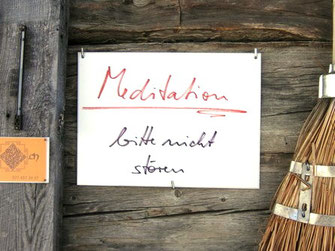Yoga in Daily Life
There are a lot of yoga schools and yoga courses. One can also book Yoga-Retreats. But what is yoga in daily life? Yoga without yoga pants and without yoga mats? There are only two kinds of yoga,
the first one you may even learn and practise without a yoga teacher!
The Bhagavad Gita, one of the Holy Scriptures of the Hindus, explains those two kinds of yoga, each in a separate chapter: the yoga of action and the yoga of knowledge – Karma Yoga (chapter 3)
and Jnana Yoga (chapter 2).
Other types of yoga are based on yoga of action and yoga of knowledge.

Yoga of Action
Karma Yoga
Karma in general means “action” and in the actual context it has nothing to do with “good” or “bad” karma.
The Bhagavad Gita explains Karma Yoga in the third chapter. Yoga is “awareness in action”. And of what are we aware? For sure not of the body or a body exercise; we do not want to be aware of the transience but about the Reality.
Conscious acting in daily life means: We act and at the same time we watch ourselves act.
We may say: we stand beside ourselves and observe. Hence a distance is created between us on one side and the acting body with the thinking mind on the other.
Thus we become our own coach in action and our own observer and advisor in emotions – our own psychotherapist. :-)
The same mind which was functioning unobserved and uncontrolled is now the observing and controlling authority at the same time!
- The mind controls the deeds, the speech and the thoughts.
This is how the mind leads itself to liberation.
Yoga of Knowlegde
Jnana Yoga
The Gita has 18 chapters, 18 times the same; but each time from a different point of view. Similar to the 4 Gospels.
Scientific knowledge and technical knowledge are continuously out of date. But, there is also a knowledge that never gets obsolete.
The yoga of knowledge deals with THE Knowledge – with the knowledge about the difference of the illusion and the Reality – about the difference of the body with the mind and the True Self.
In the Bhagavad Gita, in the second chapter, this Knowledge about the True Self, of God (Atman), is revealed. In order to acquire the Knowledge again and again (in a different form) and to resolve questions and doubts a teacher (a Guru) is needed. This is one of the "main tasks" of a Guru (if he has any : transmit knowledge and answers questions. A second "task" is to set an example.
With his own action the Guru sets a good example. You will observe, question it and act in a similar way. This again is yoga of action.
Do you practise yoga?
When people ask me,
“do you practise yoga?”,
I always reply,
“yes, I do!”.
Then most of them think I can do handstands and waggle with the feet.
![]()

That is it what we do: Jnana Yoga. Or simply : meditation.
Patanjali Yoga Sutras
Definition “Yoga”
Some time between 4th and 2nd century BC Patanjali wrote the Yoga Sutras. They deal mostly with the yoga of knowledge. The accumulated knowledge will be internalized and realized by meditation.
In the 2nd Sutra Patanjali gives the definition for yoga (in Sanskrit):
yogash chitta vritti nirodha. Yoga (or meditation) is to stop (nirodha) the whirling (vritti) of the mind (chitta).
Even though Karma Yoga and Jnana Yoga are alternating in life, yoga of action comes first. After having learned to act “rightly”, perform work in a concentrated and perfect way in a spiritual sense, thus inner cleaning takes place. When there is nothing more to do, then the time has come when you may withdraw and perform jnana-yoga, the yoga of knowledge or yoga of wisdom.
Practice
First:
Concentrated and attentive actions. E.g. while preparing carrots pay full concentration to the working hands; at the same time observe yourself as you work. There are no thoughts outside the trencher. Whether you like this work or not does no matter. The work has to be done. Carrot salad without carrots does not exist.
Second:
Get the knowledge. Read the four Gospels (more is not needed), most of all the Sermon on the Mount. Be detached from known patterns of explications and try to understand.
Wish to meet your teacher who will explain the Gospels and other Holy Scriptures. (More and more there will be female teachers as well
!)
Third:
Get absorbed into prayer and learn to meditate. Thereby much will become clear by itself! And: “Everything will fall into place”.

